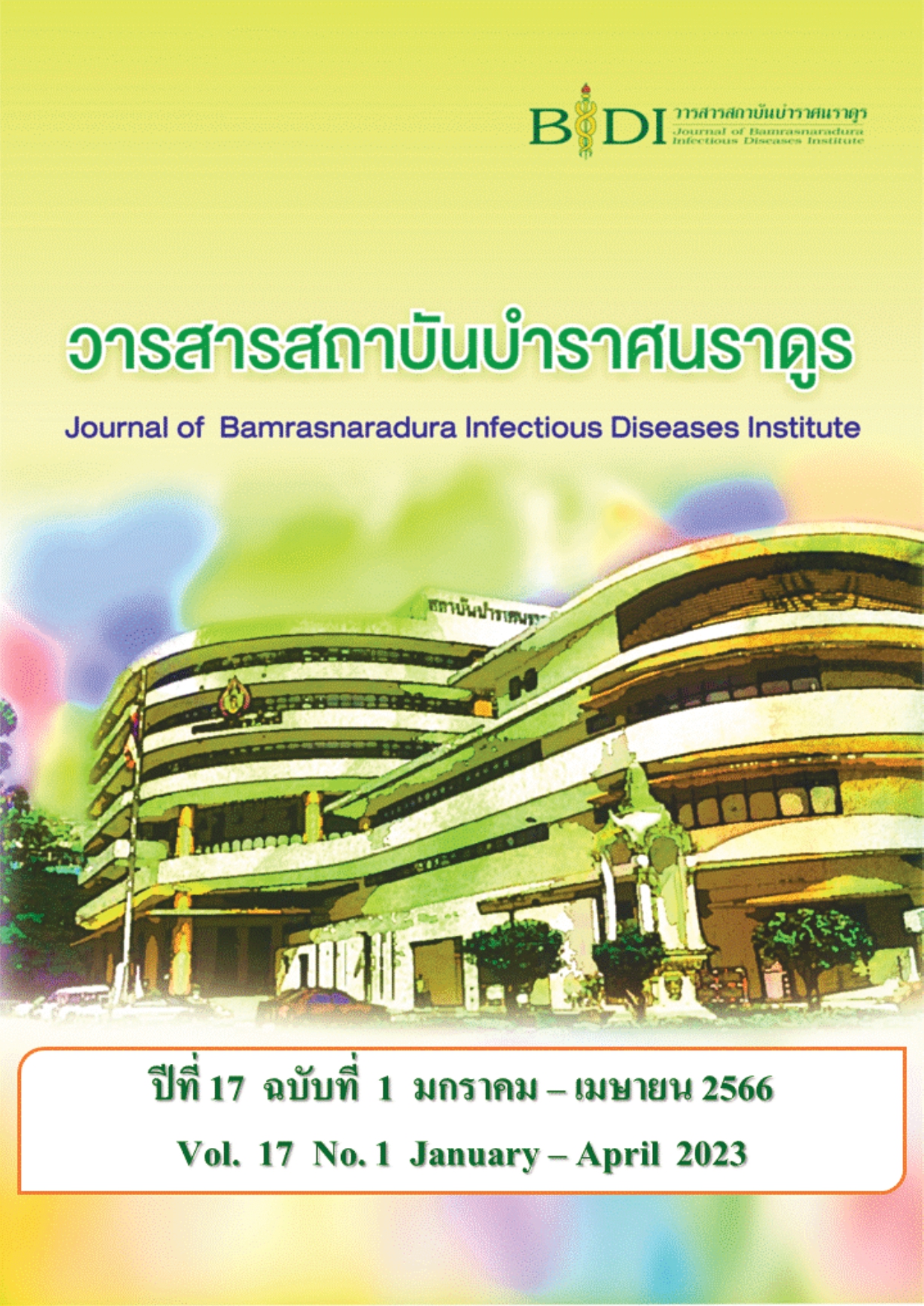การกำจัดอนุมูลอิสระจากกรดเปอร์อะซิติกในตัวกรองเลือดที่ใช้ซ้ำด้วยกรดแอสคอร์บิก
Main Article Content
บทคัดย่อ
กรดเปอร์อะซิติกนิยมนำมาใช้กำจัดจุลชีพในตัวกรองเลือดที่ใช้ซ้ำสำหรับผู้ป่วยที่เข้ารับการฟอกเลือด ซึ่งอาจมีการตกค้างของสารดังกล่าวในเยื่อกรองฟอกเลือดได้แม้จะผ่านการกำจัดออกตามมาตรฐาน ทำให้เกิดอนุมูลอิสระที่มีผลต่อพยาธิสภาพของโรค ผู้วิจัยจึงทำการทดสอบว่ามีการตกค้างของกรดเปอร์อะซิติกและไฮโดรเจนเปอร์ออกไซด์ที่ได้จากการสลายตัวจากกรดเปอร์อะซิติกในเยื่อกรองฟอกเลือดภายหลังจากการกำจัดด้วยวิธีมาตรฐานแล้วและหาปริมาณของกรดแอสคอร์บิกที่เหมาะสมต่อการกำจัดสารอนุมูลอิสระ โดยนำตัวกรองเลือดที่ผ่านการใช้ซ้ำด้วยจำนวนครั้งที่มากที่สุด (N=40) แบ่งออกเป็นกลุ่มควบคุม (N=15) และ กลุ่มทดลองที่ฉีดกรดแอสคอร์บิกความเข้มข้น 3.9 - 500 มิลลิกรัม (N=25) จำนวน 5 กลุ่มย่อย ตัวกรองเลือดที่ผ่านการกำจัดเชื้อโรคด้วยกรดเปอร์อะซิติกจะถูกชะล้างด้วยน้ำเกลือนอร์มัลโดยวิธี ultrafiltration ของเครื่องไตเทียม จากนั้นปิดการไหลของน้ำเกลือนอร์มัลและน้ำยาฟอกเลือด เมื่อทำการวัดปริมาณสารตกค้างโดยแผ่นทดสอบกรดเปอร์อะซิติกและไฮโดรเจนเปอร์ออกไซด์ที่เวลา 2 - 180 นาที ผลการทดลองพบว่า ในกลุ่มควบคุมมีกรดเปอร์อะซิติกและไฮโดรเจนเปอร์ออกไซด์ทั้งในส่วนของ blood และ dialysate compartments และมีการเพิ่มขึ้นของไฮโดรเจนเปอร์ออกไซด์ตามระยะเวลาอย่างมีนัยสำคัญ ในขณะที่กลุ่มทดลองที่ให้กรดแอสคอร์บิกเมื่อเพิ่มความเข้มข้นที่สูงขึ้นพบว่าสามารถกำจัดไฮโดรเจนเปอร์ออกไซด์ได้มากขึ้น ตามลำดับ โดยเฉพาะกรดแอสคอร์บิก 125 มิลลิกรัม สามารถกำจัดอนุมูลอิสระทั้งสองชนิดได้จนหมดทั้งในส่วนของ blood และ dialysate compartments อย่างมีนัยสำคัญที่ P < 0.001 ดังนั้นแนวปฏิบัติในการนำตัวกรองเลือดกลับมาใช้ซ้ำจึงมีข้อเสนอแนะคือ การเติมกรดแอสคอร์บิก 125 มิลลิกรัมเข้าสู่ตัวกรองเลือดขณะทำการล้างตัวกรองเลือด ซึ่งสามารถช่วยเพิ่มคุณภาพการดูแลรักษาให้กับชีวิตของผู้ป่วยได้
Article Details
เอกสารอ้างอิง
Leypoldt JK, Murthy BV, Pereira BJ, Levin NW, Petersen J, Jani A. Does reuse have clinically important effects on dialyzer function? Semin Dial. 2000 Sep - Oct; 13(5):281-90. doi: 10.1046/j.1525-139x.2000.00075.x.
AAMI. Recommended practice for reused of hemodilayzers. Association for advancement of medical instrumentation. Arlington: American National Standards Institute, Inc., 2008.
Wilson JN. Paracetic acid as an alternative disinfectant. Clear Water Winter 2014: 17-9.
Kitis M. Disinfection of wastewater with peracetic acid: a review. Environ Int. 2004 Mar; 30(1):47-55. doi: 10.1016/S0160-4120(03)00147-8.
Inupakutika MA, Sengupta S, Devireddy AR, Azad RK, Mittler R. The evolution of reactive oxygen species metabolism. J Exp Bot. 2016 Nov; 67(21): 5933-5943. doi: 10.1093/jxb/erw382.
De Andrade Junior DR, de Souza RB, dos Santos SA, de Andrade DR . Oxygen free radicals and pulmonary disease. J Bras Pneumol 2005; 31(1): 60-8. doi: https://doi.org/10.1590/S1806-37132005000100011.
Zhang KY, Zuo L. Vitamin C supplementation in patients on maintenance dialysis. World J Clin Urol 2014; 3(3): 344-350. doi: 10.5410/wjcu.v3.i3.344.
Du J, Cullen JJ, Buettner GR. Ascorbic acid: chemistry, biology and the treatment of cancer. Biochim Biophys Acta. 2012 Dec; 1826(2): 443-57. doi: 10.1016/j.bbcan.2012.06.003.
Pehlivan FE. Vitamin C: An antioxidant agent. In: Hamza AH, editor. Vitamin C. London: IntechOpen Croatia; 2017. P.23-35. doi: https://doi.org/10.5772/intechopen.69660
Lobo V, Patil A, Phatak A, Chandra N. Free radicals, antioxidants and functional foods: Impact on human health. Pharmacogn Rev. 2010 Jul; 4(8): 118-26. doi: 10.4103/0973-7847.70902.
Liakopoulos V, Roumeliotis S, Gorny X, Dounousi E, Mertens PR. Oxidative Stress in Hemodialysis Patients: A Review of the Literature. Oxid Med Cell Longev 2017; 2017: 1-22. doi: 10.1155/2017/3081856.
Klarenbach SW, Moist LM, Foley RN, Barrett BJ, Madore F, White CT, et al. Clinical practice guidelines for supplemental therapies and issues. Kidney Int Suppl 2008; 74(110): S19-24. doi: 10.1038/ki.2008.271.
Woong Kang D, Yong Ahn C, Kwan Ryu B, Chul Shin B, Hoon Chung J, Lee Kim H. The effect of intravenous ascorbic acid in hemodialysis patients with normoferritinemic anemia. Kidney Res Clin Pract 2012; 31(1): 48-53. doi: 10.1016/j.krcp.2012.01.002.
Pru C, Eaton J, Kjellstrand C. Vitamin C intoxication and hyperoxalemia in chronic hemodialysis patients. Nephron 1985; 39(2): 112-6. doi: 10.1159/000183353.
Yuan Z, NI Y, Van Heiningen ARP. Kinetics of Peracetic Acid Decomposition Part I: Spontaneous Decomposition at Typical Pulp Bleaching Conditions. Can J Chem Eng 1997; 75: 37-41. doi: https://doi.org/10.1021/ja00898a016
Dominguez - Henao L, Turolla A, Monticelli D, Antonelli M. Assessment of a colorimetric method for the measurement of low concentrations of peracetic acid and hydrogen peroxide in water. Talanta 2018; 183: 209-15. 10.1016/j.talanta.2018.02.078.
Cai M, Sun P, Zhang L, Huang CH. UV/Peracetic Acid for Degradation of Pharmaceuticals and Reactive Species Evaluation. Environ Sci Technol 2017; 51(24): 14217-24. doi: 10.1021/acs.est.7b04694.
Handelman GJ. Vitamin C deficiency in dialysis patients are we perceiving the tip of an iceberg? Nephrol Dial Transplant 2007; 22(2): 328-31. doi: 10.1093/ndt/gfl534.
Canavese C, Petrarulo M, Massarenti P, Berutti S, Fenoglio R, Pauletto D. Long-term, low-dose, Intravenous vitamin C leads to plasma calcium oxalate supersaturation in hemodialysis patients. Am J Kidney Dis 2005; 45(3): 540-9. doi: 10.1053/j.ajkd.2004.10.025.
Selistre LDS, Cochat P, Rech DL, Parant F, Souza VC, Dubourg L. Association between glomerular filtration rate (measured by high-performance liquid chromatography with iohexol) and plasma oxalate. J Bras Nefrol. 2018 Jan - Mar; 40(1): 73-76. doi: 10.1590/1678-4685-JBN-3743.
France NC, Holland PT, Wallace MR. Contribution of dialysis to endogenous oxalate production in patients with chronic renal failure. Clin Chem 1994; 40(8): 1544-48.
Celasun B, Safali M, Yenicesu M. Secondary oxalosis of bone in a dialysis patient. Scand J Urol Nephrol 1995; 29(2): 211-4. doi: 10.3109/00365599509180564.
Sullivan JF, Eisenstein AB. Ascorbic acid depletion in patients undergoing chronic hemodialysis. Am J Clin Nutr 1970; 23(10): 1339-46. doi: 10.1093/ajcn/23.10.1339.


